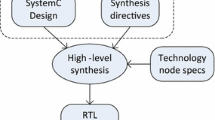Abstract
Modular decomposition and functional abstraction are commonly employed to accommodate the growing size and complexity of modern designs. In the test domain, a divide-and-conquer type of approach is utilized, wherein test is locally generated for each module and consequently translated to global design test. We present an RTL analysis methodology that identifies the test justification and propagation bottlenecks, facilitating a judicious DFT insertion process. We introduce two mechanisms for capturing, without reasoning on the complete functional space, data and control module behavior related to test translation. A traversal algorithm that identifies the test translation bottlenecks in the design is described. The algorithm is capable of handling cyclic behavior, reconvergence and variable bit-widths in an efficient manner. We demonstrate our scheme on representative examples, unveiling its potential of accurately identifying and consequently minimizing the reported controllability and observability bottlenecks of large, modular designs.
Similar content being viewed by others
References
C-H. Chen, T. Karnik, and D.G. Saab, “Structural and Behavioral Synthesis for Testability Techniques,” IEEE Transactions on CAD of Integrated Circuits and Systems, Vol. 13, No. 6, pp. 777–785, June 1994.
I. Ghosh, A. Raghunathan, and N.K. Jha, “A Design for Testability Technique for RTL Circuits using Control/Data Flow Extraction,” Proc. IEEE/ACM International Conference on Computer Aided Design, 1996, pp. 329–336.
I. Ghosh, N. Jha, and S. Dey, “A Low-Overhead Design for Testability and Test Generation Technique for Core-Based Systems,” Proc. International Test Conference, 1997, pp. 50–59.
A. Orailoğlu and I. Harris, “Microarchitectural Synthesis for Rapid BIST Testing,” IEEE Transactions on CAD of Integrated Circuits and Systems, Vol. 6, No. 6, pp. 573–586, June 1997.
B. Pouya and N. Touba, “Modifying User-Defined Logic for Test Access to Embedded Cores,” Proc. International Test Conference, 1997, pp. 60–68.
R.S. Tupuri and J.A. Abraham, “A Novel Test Generation Method for Processors using Commercial ATPG,” Proc. International Test Conference, 1997, pp. 743–752.
P. Vishakantaiah, T. Thomas, J.A. Abraham, and M.S. Abadir, “AMBIANT: Automatic Generation of Behavioral Modifications for Testability,” Proc. IEEE International Conference on Computer Design, 1993, pp. 63–66.
F. Corno, P. Prinetto, and M. Sonza Reorda, “Testability Analysis and ATPG on Behavioral RT-Level VHDL,” Proc. International Test Conference, 1997, pp. 753–759.
J. Lee and J. Patel, “Testability Analysis Based on Structural and Behavioral Information,” Proc. 11th IEEE VLSI Test Symposium, 1993, pp. 139–145.
P. Vishakantaiah, J.A. Abraham, and M.S. Abadir, “Automatic Test Knowledge Extraction from VHDL (ATKET),” Proc. 29th ACM/IEEE Design Automation Conference, 1992, pp. 273–278.
B.T. Murray and J.P. Hayes, “Test Propagation Through Modules and Circuits,” Proc. International Test Conference, 1991, pp. 748–757.
M.C. Hansen and J.P. Hayes, “High-Level Test Generation Using Symbolic Scheduling,” Proc. International Test Conference, 1995, pp. 586–595.
K.T. Cheng and A.S. Krishnakumar, “Automatic Functional Test Generation using the Extended Finite State Machine Model,” Proc. 30th ACM/IEEE Design Automation Conference, 1992, pp. 86–91.
D. Moundanos, J.A. Abraham, and Y.V. Hoskote, “A Unified Framework for Design Validation and Manufacturing Test,” Proc. International Test Conference, 1996, pp. 875–884.
J.P. Hayes, Computer Architecture and Organization, 3rd edition, McGraw-Hill, 1998.
P. Ashenden, The Designer's Guide to VHDL, 1st edition, Morgan-Kaufmann Publishers Inc., 1996.
T. Niermann and J. Patel, “HITEC: A Test Generation Package for Sequential Circuits,” Proc. European Conference on Design Automation, 1992, pp. 214–218.
T. Niermann, W.T. Cheng, and J. Patel, “PROOFS: A Fast, Memory Efficient Sequential Circuit Fault Simulator,” Proc. 27th ACM/IEEE Design Automation Conference, 1990, pp. 535–540.
Author information
Authors and Affiliations
Rights and permissions
About this article
Cite this article
Makris, Y., Orailogcaron;lu, A. RTL Test Justification and Propagation Analysis for Modular Designs. Journal of Electronic Testing 13, 105–120 (1998). https://doi.org/10.1023/A:1008301720070
Issue Date:
DOI: https://doi.org/10.1023/A:1008301720070




